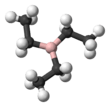Triethylborane
| |||
| Names | |||
|---|---|---|---|
| IUPAC name
Triethylborane | |||
| Other names
Triethylborine, triethylboron | |||
| Identifiers | |||
3D model (JSmol) |
|||
| ChemSpider | |||
| ECHA InfoCard | 100.002.383 | ||
| EC Number | 202-620-9 | ||
PubChem CID |
|||
| |||
| |||
| Properties | |||
| C6H15B | |||
| Molar mass | 98.00 g/mol | ||
| Appearance | Colorless to pale yellow liquid | ||
| Density | 0.677 g/cm3 | ||
| Melting point | −93 °C (−135 °F; 180 K) | ||
| Boiling point | 95 °C (203 °F; 368 K) | ||
| Not applicable; highly reactive | |||
| Hazards | |||
| Main hazards | Spontaneously flammable in air; causes burns | ||
| Safety data sheet | External SDS | ||
| R-phrases (outdated) | R11 R14/15 R17 R19 R34 R35 R36/37 | ||
| S-phrases (outdated) | S6 S7/8 S16 S33 S36/37/39 S43A S45 S29 | ||
| NFPA 704 | |||
| Flash point | < −20 °C (−4 °F; 253 K) | ||
| −20 °C (−4 °F; 253 K) | |||
| Related compounds | |||
Related compounds |
| ||
Except where otherwise noted, data are given for materials in their standard state (at 25 °C [77 °F], 100 kPa). | |||
| Infobox references | |||
Triethylborane (TEB), also called triethylboron, is an organoborane (a compound with a B-C bond). It is a colorless pyrophoric liquid. Its chemical formula is (C2H5)3B, abbreviated Et3B. It is soluble in organic solvents tetrahydrofuran and hexane.
Preparation and structure
Triethylborane is prepared by the reaction of trimethyl borate with triethylaluminium:[1]
- Et3Al + (MeO)3B → Et3B + (MeO)3Al
The molecule is monomeric, unlike H3B and Et3Al, which tend to dimerize. It has a planar BC3 core.[1]
Applications
Turbojet engine
Triethylborane was used to ignite the JP-7 fuel in the Pratt & Whitney J58 turbojet/ramjet engines powering the Lockheed SR-71,[2] and its predecessor A-12 OXCART. Triethylborane is suitable for this because of its pyrophoric properties, especially the fact that it burns with very high temperature. It was chosen as an ignition method for reliability reasons, and in the case of the Blackbird, because the JP-7 fuel has very low volatility and is difficult to ignite. Conventional ignition plugs posed a high risk of malfunction. It was used to start each engine and to ignite the afterburners.[3]
Rocket
Mixed with 10–15% triethylaluminium, it was used before lift-off to ignite the F-1 engines on the Saturn V rocket.[4]
The SpaceX Falcon 9 rocket also uses a triethylaluminium-triethylborane mixture as a first and second stage ignitor.[5]
Organic chemistry
Industrially, triethylborane is used as an initiator in radical reactions, where it is effective even at low temperatures.[1] As an initiator, it can replace some organotin compounds.
It reacts with metal enolates, yielding enoxytriethylborates that can be C-alkylated more selectively than in its absence.[6] It is used in the Barton–McCombie deoxygenation reaction for deoxygenation of alcohols. In combination with lithium tri-tert-butoxyaluminum hydride it cleaves ethers. For example, THF is converted, after hydrolysis, to butanol. It also promotes certain variants of the Reformatskii reaction.[7]
Triethylborane is the precursor to the reducing agents lithium triethylborohydride ("Superhydride") and sodium triethylborohydride.[8]
- MH + Et3B → MBHEt3 (M = Li, Na)
Safety
Triethylborane is strongly pyrophoric, with an autoignition temperature of −20 °C (−4 °F),[9] burning with an apple-green flame characteristic for boron compounds. Thus, it is typically handled and stored using air-free techniques.
See also
References
- 1 2 3 Robert J. Brotherton, C. Joseph Weber, Clarence R. Guibert, John L. Little "Boron Compounds" in Ullmann's Encyclopedia of Industrial Chemistry 2000, Wiley-VCH. doi:10.1002/14356007.a04_309
- ↑ "Lockheed SR-71 Blackbird". March Field Air Museum. Archived from the original on 2000-03-04. Retrieved 2009-05-05.
- ↑ "Lockheed SR-71 Blackbird Flight Manual". www.sr-71.org. Retrieved 2011-01-26.
- ↑ A. Young (2008). The Saturn V F-1 Engine: Powering Apollo Into History. Springer. p. 86. ISBN 0-387-09629-9.
- ↑ Mission Status Center, June 2, 2010, 1905 GMT, SpaceflightNow, accessed 2010-06-02, Quotation: "The flanges will link the rocket with ground storage tanks containing liquid oxygen, kerosene fuel, helium, gaseous nitrogen and the first stage ignitor source called triethylaluminum-triethylborane, better known as TEA-TEB."
- ↑ Crich, David (2013-05-30). Handbook of Reagents for Organic Synthesis, Reagents for Radical and Radical Ion Chemistry. John Wiley & Sons. ISBN 1118634896.
- ↑ Yoshinori Yamamoto, Takehiko Yoshimitsu, John L. Wood, Laura Nicole Schacherer "Triethylborane" Encyclopedia of Reagents for Organic Synthesis. doi:10.1002/047084289X.rt219.pub3
- ↑ Binger, P.; Köster, R., "Sodium triethylhydroborate, sodium tetraethylborate, and sodium triethyl-1-propynylborate", Inorg. Synth. 1974, 15, 136-141. doi:10.1002/9780470132463.ch31
- ↑ Fuels and Chemicals - Autoignition Temperatures


